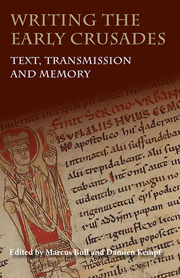Book contents
- Frontmatter
- Contents
- Acknowledgements
- List of Contributors
- List of Abbreviations
- Introduction
- Baldric of Bourgueil and the Familia Christi
- Guibert of Nogent, Albert of Aachen and Fulcher of Chartres: Three Crusade Chronicles Intersect
- Understanding the Greek Sources for the First Crusade
- The Monte Cassino Tradition of the First Crusade: From the Chronica Monasterii Casinensis to the Hystoria de via et recuperatione Antiochiae atque Ierusolymarum
- Nova Peregrinatio: The First Crusade as a Pilgrimage in Contemporary Latin Narratives
- What Really Happened to Eurvin de Créel's Donkey? Anecdotes in Sources for the First Crusade
- Porta Clausa: Trial and Triumph at the Gates of Jerusalem
- The Historia Iherosolimitana of Robert the Monk and the Coronation of Louis VI
- Towards a Textual Archaeology of the First Crusade
- Robert the Monk and his Source(s)
- Rewriting the History Books: The First Crusade and the Past
- The Ideal of Knighthood in English and French Writing, 1100–1230: Crusade, Piety, Chivalry and Patriotism
- Index
The Monte Cassino Tradition of the First Crusade: From the Chronica Monasterii Casinensis to the Hystoria de via et recuperatione Antiochiae atque Ierusolymarum
Published online by Cambridge University Press: 05 May 2014
- Frontmatter
- Contents
- Acknowledgements
- List of Contributors
- List of Abbreviations
- Introduction
- Baldric of Bourgueil and the Familia Christi
- Guibert of Nogent, Albert of Aachen and Fulcher of Chartres: Three Crusade Chronicles Intersect
- Understanding the Greek Sources for the First Crusade
- The Monte Cassino Tradition of the First Crusade: From the Chronica Monasterii Casinensis to the Hystoria de via et recuperatione Antiochiae atque Ierusolymarum
- Nova Peregrinatio: The First Crusade as a Pilgrimage in Contemporary Latin Narratives
- What Really Happened to Eurvin de Créel's Donkey? Anecdotes in Sources for the First Crusade
- Porta Clausa: Trial and Triumph at the Gates of Jerusalem
- The Historia Iherosolimitana of Robert the Monk and the Coronation of Louis VI
- Towards a Textual Archaeology of the First Crusade
- Robert the Monk and his Source(s)
- Rewriting the History Books: The First Crusade and the Past
- The Ideal of Knighthood in English and French Writing, 1100–1230: Crusade, Piety, Chivalry and Patriotism
- Index
Summary
When focusing on the analysis of texts in order to reconstruct the past, we often overlook the importance of the geography of historiographical memory. One exception, made some years ago, is the case study of the abbey of Fleury-sur-Loire by Robert-Henri Bautier in an essay whose conclusions have since been resumed and expanded. Indeed, in the period between the end of the tenth century and the first decades of the twelfth, this abbey was responsible for the writing of some of the most important texts that represent the origins of ‘official’ French historiography in the Middle Ages, by reason of the strong organic link that it established with the Capetian dynasty as it assumed a more central role in the French political scene. It can be suggested that the case of Monte Cassino deserves similar attention in the light of its historiographical output in the period close to the events of the First Crusade. Situated on one of the most important roads that connected northern and southern Italy, and lying less than 100 kilometres from Rome, the monastery of Monte Cassino played a central role, not only in the history of western monasticism, but also in the intellectual life of the central Middle Ages, as has been demonstrated, for example, by the work of Herbert Bloch and John Cowdrey.
Let us start by taking a step back.
- Type
- Chapter
- Information
- Writing the Early CrusadesText, Transmission and Memory, pp. 53 - 62Publisher: Boydell & BrewerPrint publication year: 2014



